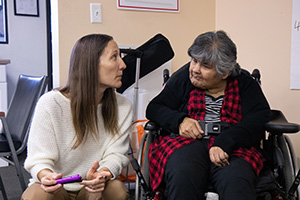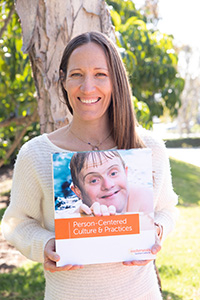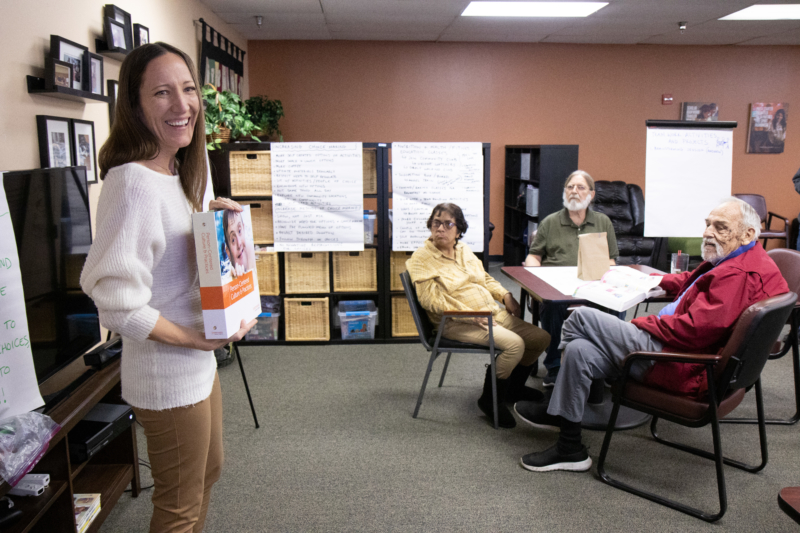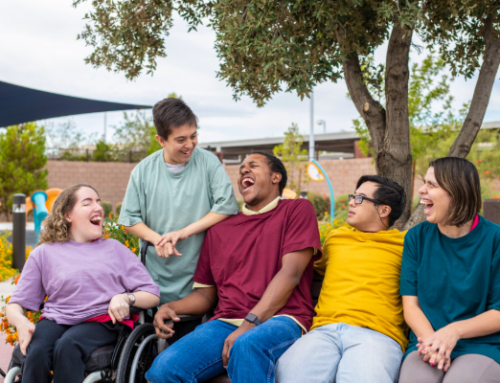By Amber Carey-Navarrete
 Nineteen years ago, a role at Easterseals appeared in my job search at my University’s career center and I applied. I was hooked from day one and knew Easterseals was the right organization for me and my double major in psychology and sociology. I loved science and social justice and questions around how we become who we are in life. I wanted to work to create environments that empowered people and helped them overcome society’s barriers.
Nineteen years ago, a role at Easterseals appeared in my job search at my University’s career center and I applied. I was hooked from day one and knew Easterseals was the right organization for me and my double major in psychology and sociology. I loved science and social justice and questions around how we become who we are in life. I wanted to work to create environments that empowered people and helped them overcome society’s barriers.
While I came into the field with very little experience with individuals with disabilities, I quickly learned that listening was the most valuable skill to have. I had fun working with different people to find their voices and explore their ideas and interests. I observed people become empowered in planning their own days and their own lives. I didn’t realize it at the time but this was the informal beginning of person-centered support practices.
When I began overseeing Easterseals’ more therapeutic-focused services, I noticed that despite the respect and support associates provided, people weren’t yet empowered to express themselves. Even when participants had an effective means of communication, associates still made many decisions in their lives. Clearly many locations still needed a person-centered support program. That was when I promised to find a way to empower every person to find their voice, make choices and have control in their lives.
Despite my passion and energy, it still took years to move the process from the theoretical to the practical. I had all the theories lined up, lots of meetings, and consultants who would come out to provide demonstrations for how we could move the needle, but nothing would stick. If the desired outcome didn’t happen right away, our associates went back to previous methods.
The decision was made to focus on a smaller, more targeted group. A pilot process was launched at one selected location so I could move past the discussions and help develop the most practical implementation possible. Focusing on one place allowed me to be more hands-on and dig into the details of the process. I was able to directly join in with shaping a team approach, team planning and preparation for implementation.
I knew a summit had been reached when peers started teaching successful methods to each other and the rollout of each program became more streamlined. It became clear that the process was working instead of just one particular tool or system.
Around this time I learned that National Easterseals would be hosting a workshop about person-centered care and practice for older adult day services. The workshop ended up teaching me how to use critical measurement tools to establish a baseline for my work and how to measure how much the program was advancing as we moved forward. The final piece of the program was complete!
Thanks to the innovative new methods employed, associates learned new things about individuals they had worked with for a long time. Different people started hanging out together, new interests were explored, and everyone got to know each other in different ways than they had previously. It was incredible watching people find their voices, trust that we would listen, and begin directing their own days.
 One of the early examples of the program’s success came from a woman named Susan. Susan usually participated in knitting or crafting, but providing her with visual indicators of a wider variety of options opened up her interests and the awareness that our associates had about her. She wanted to play sports! She picked out the visual options for baseball, volleyball, and basketball and enjoyed the new experience of playing with others who enjoyed them too.
One of the early examples of the program’s success came from a woman named Susan. Susan usually participated in knitting or crafting, but providing her with visual indicators of a wider variety of options opened up her interests and the awareness that our associates had about her. She wanted to play sports! She picked out the visual options for baseball, volleyball, and basketball and enjoyed the new experience of playing with others who enjoyed them too.
Seeing these outcomes, Easterseals Southern California became interested in replicating this approach throughout its services. At that point, I had the full support of the organization to lead our other adult day services through a person-centered culture change journey and a team to work with.
After training multiple service locations, guiding them through implementation and seeing the impact of person-centered culture change, we decided to document the process. So I set out to create a manual. Originally intended to support replication of person-centered culture change more rapidly throughout Easterseals, the farther we got in developing the manual, the more interest we received from other local and regional organizations. We realized then that the manual, and our approach to person-centered culture change and practices could be far reaching and help organizations throughout Southern California and beyond enhance their services. This is how Person-Centered Culture and Practices© (PCCP) came to be.
 Person-centered philosophy has existed in the aging and disability industries for decades and continues to evolve. It was important to me to create a resource that did not just discuss person-centered philosophy, but takes that philosophy and makes it into a practical tool that guides programs through implementation step-by-step; a resource that encourages organizational learning so it can continue to evolve. I am thrilled to see and hear the successes others are having as they’ve begun implementing the PCCP trainings and process. Each new success is just as exciting and powerful as the first. Each person that PCCP supports to find their voice and empowers to take control of his or her life makes it all worthwhile.
Person-centered philosophy has existed in the aging and disability industries for decades and continues to evolve. It was important to me to create a resource that did not just discuss person-centered philosophy, but takes that philosophy and makes it into a practical tool that guides programs through implementation step-by-step; a resource that encourages organizational learning so it can continue to evolve. I am thrilled to see and hear the successes others are having as they’ve begun implementing the PCCP trainings and process. Each new success is just as exciting and powerful as the first. Each person that PCCP supports to find their voice and empowers to take control of his or her life makes it all worthwhile.






Leave A Comment